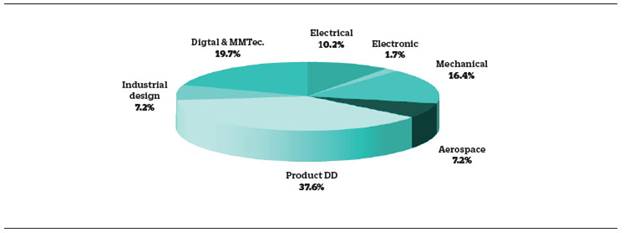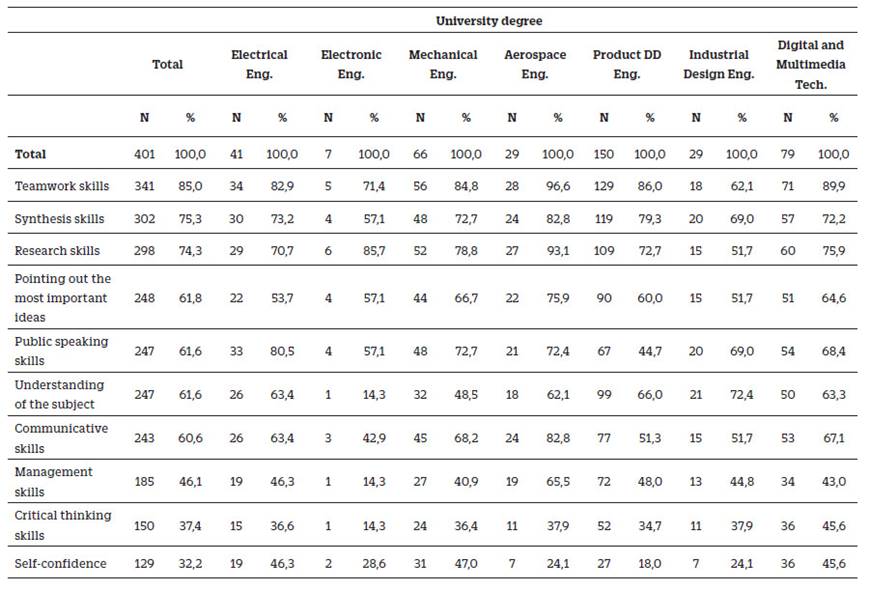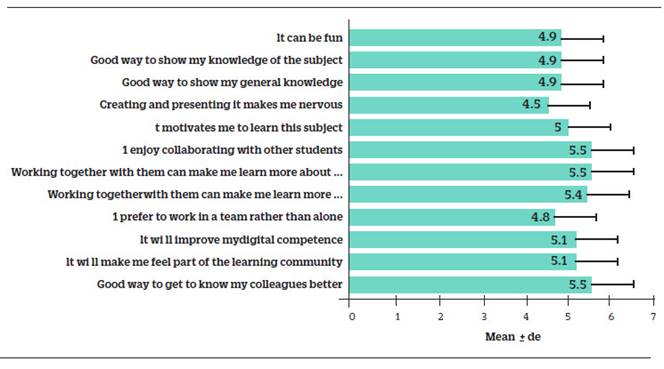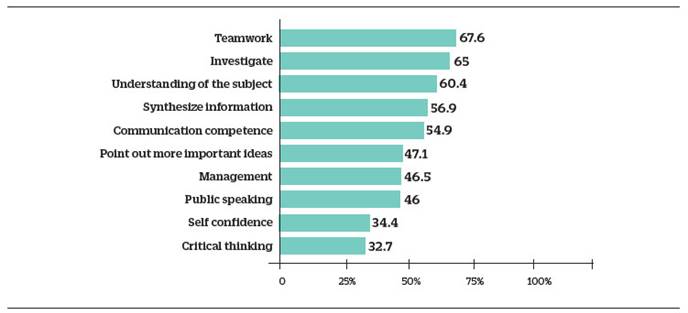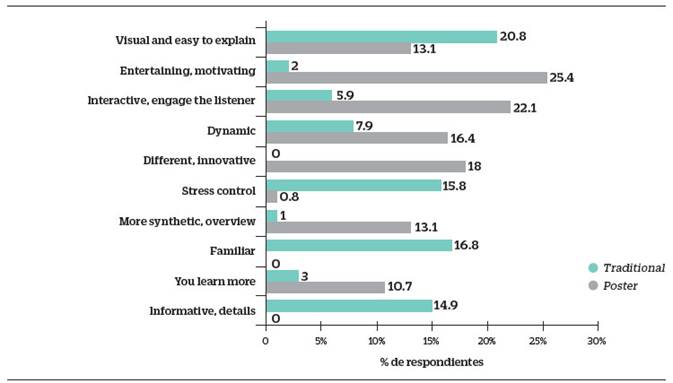Introduction
The implementation of the European Higher Education Area (EHEA) has posed major challenges for the Spanish university system. This new model advocates the adoption of a teaching philosophy that prioritises not only the acquisition of academic content, but also a series of cross-curricular competences that facilitate students’ access to the labour market. Cross-curricular competences are regarded as a necessity to access an ever-increasing volatile labour market. As a result, university programmes need to ensure that their undergraduates enhance these skills in the form of competences throughout their studies so that they can subsequently meet the requirements imposed by the labour market.
This current teaching scenario requires the implementation of active methodologies in the classroom through which the student adopts a leading role. In this regard, the academic poster is a case in point, since it not only allows for the integration of competences in an effective way, but also the implementation of different educational methodologies in line wixth this educational trend (Salcines-Talledo & González-Fernández, 2019). Surprisingly, the use of the academic poster as a pedagogical resource in university settings has received little attention to date. Most of the applications can be found in the fields of hard sciences and the medical field, especially nursing and medicine (Moreno & García, 2017). However, interest in academic posters as a pedagogical tool has grown in the last years (D’Angelo, 2016) and drawn the attention of researchers. On this basis, the main objective of this paper is to analyse the effectiveness of the academic poster as a pedagogical resource for the promotion of cross-curricular competences in engineering students.
Theoretical framework
Academic posters in teaching practice
The academic poster is a scientific communication tool through which a researcher or group of researchers graphically present the results of their research, experiences, or projects. Its use became popular in the 1980s when the scientific community recognised its potential in promoting learning (Bracher et al., 1998) as well as the pedagogical value of using visual material in academic presentations (De la Cruz-Vargas et al., 2016). It is currently one of the main means to transmit scientific knowledge in lectures (García-Manso, 2019), so much so that a wealth of tips and techniques on how to produce posters as well as templates are readily available (D’Angelo, 2016; Berbey-Álvarez et al., 2017). However, as already foregrounded, its use as a pedagogical resource has received little attention in comparison to other types of educational intervention (De La Cruz-Vargas et al., 2016).
Notwithstanding this scarcity of research, the few studies conducted to date show the potential of such a resource not only as a way of acquiring curricular content, but also as a key element for promoting what Petterson (2017) refers to as soft competences 1. According to Halligan (2008), the creation of an academic poster requires: (1) identification of a problem; (2) formulation of a starting idea or question; (3) observational practice and literature review; and (4) analysis and synthesis of information and recommendations. Thus, students become involved "in a hands-on, problem-focused activity" (Bracher et al., 1998, p. 552).
In educational terms, the academic poster promotes a large number of necessary competencies when facing a competitive labour market. The academic poster promotes critical thinking, information retrieval and communication skills. This is mainly due to the fact that its use as a teaching resource generates a type of participatory-reflective learning (Salcines-Talledo & González-Fernández, 2019). It stimulates the exchange of information, academic discussion and the exchange of opinions and experiences (Moreno & García, 2017), which are cornerstones for scientific and social progress. This reflection and information exchange process also reinforces problem-solving skills, self-regulation, and cooperation (Canales & Schmal, 2013; García-Manso, 2019). Through discussion, the student links their own ideas to new knowledge, which fosters abstract reasoning, clarification of concepts and appreciation of the relevance of the content being dealt with (Bracher et al., 1998).
Another major advantage of the academic poster is that it is possible to combine both visual material and text (García-Manso, 2019). Graphic information, when used to support linguistic content, can contribute significantly to the comprehension of academic content. In fact, as far as textual content is concerned, time and space limitations require synthesising the information (García-Manso, 2019), which can be understood as another educational advantage, since it promotes cognitive stimulation, and the student climbs up the levels of Bloom’s taxonomy (Moreno & García, 2017). Additionally, the fact that the results or information contained in the poster have to be shared entails the management of bibliographic resources, the ability to select material and the enhancement of presentation skills (Canales & Schmal, 2013).
The use of the academic poster as a teaching resource responds to a need to shift towards a type of education based on active methodologies. The teacher provides students with access to the materials and presentation resources to carry out the task (Moreno & García, 2017). Thus, the lecturer leaves behind their role as a learning guide to become a strategist, consultant, and facilitator (Canales & Schmal, 2013) and empowers the student so that they can self-regulate their metacognitive skills and their own learning process. All this requires adapting the evaluation system and going beyond the mere evaluation of knowledge. The academic poster thus proves a very useful evaluation tool for allowing the teacher to evaluate not only accumulated knowledge (Moreno & García, 2017), but also cross-curricular competencies.
Enhancing cross-curricular competences
Engineering degrees constitute fundamental pillars for scientific and social progress. However, for this progress not to become stagnant and be handed down and improved by future generations, it is necessary to develop a series of competencies that go beyond hard skills, i.e., a set of specific abilities or expertise to perform certain job-related tasks. Globalisation requires the set of competencies that make up university degrees to be updated in order to facilitate new graduates access to the labour market and overcome what Patrie (1994: 53) catalogued in his study as the "readiness-to-work gap", that is, the gap that often needs to be bridged between the university and the labour market. Even though students finish their tertiary education with sufficient disciplinary knowledge, many of them are ill-prepared to tackle the challenges that the labour market imposes on them (Zainuddin et al., 2019). As a result, the EHEA proposes the implementation of actions in the classroom that can help bridge this gap and bring students closer to the reality of their future profession.
In this context, the integration of cross-curricular competences in the syllabus takes on special significance (Martínez & González, 2019). The Organization of Economic Cooperation and Development (OECD), through its Definition and Selection of Competences Project (DeSeCo), defines the term competence as "the ability to respond to complex demands and carry out various tasks appropriately. It involves a combination of practical skills, knowledge, motivation, ethical and attitudinal values, emotions and other social and behavioural components that are mobilized together to achieve effective action" (Organización para la Cooperación y el Desarrollo Económico [OECD], 2005). In the case that concerns us here, the implementation of competences in the classroom responds to the need to balance both technical and non-technical skills and facilitate students’ incorporation into an ever-increasingly competitive labour market. As Bhattacharyya (2012: 3555) points out, "a balance of both sets of skills enables an engineer to participate effectively in the global arena as well as meet competitive workplace demands". Such is their importance in today’s engineering education that professional competences have become part of the Accreditation Board of Engineering’s (ABET) list of competences in engineering education (Shuman et al., 2005).
Although ABET considers a total of six skills fundamental for a proper professional development2, in a study conducted by Torrelles et al. (2015), it was concluded that workers exhibit minor performance weaknesses such as planning, decision making, task completion and monitoring as well as notable regulation weaknesses in conflict resolution, negotiation, and avenues for improvement. This lack of work skills makes teamwork one of the essential competencies in any work environment. Students must learn to work together in multi-disciplinary teams to boost their career prospects, so this practice should be regarded as an inherent part of university education. Teamwork has further been reported to lead to improved performance in employees (Bailey et al., 2001). Therefore, it is necessary to implement actions in the classroom to bridge this gap in a way that reflects the multidisciplinary nature of most work teams in the workplace (Herrera et al., 2017).
At an educational level, cooperative learning presents itself as a highly relevant methodology to achieve such a purpose (Hebles et al., 2019). Cooperative learning makes use of small groups so that students can broaden their knowledge (Johnson et al., 2013). As opposed to a type of learning based on competitiveness and individualism, cooperative learning is based on collaboration and cooperation. To this end, each group member takes responsibility for a part of the project, creating thus a certain interdependence among them. The work will only be satisfactory if each member of the group completes the assigned part of the project and works in collaboration with the rest of the group. This cooperative structure, in turn, fosters ethical and professional responsibility. The student feels the need to accomplish the assigned task and contribute to keeping the cooperative structure of the group.
Additionally, the need to work cooperatively requires constant communication among group members. Communication is undoubtedly one of the most important competencies. Engineers need to develop social interaction skills that allow them to communicate the results and progress derived from their research and professional practice. The flow of information that an engineer receives and produces is constant: technical appraisals, drafting of minutes, reports, etc. All these acts of communication require a high degree of precision in the use of the language, hence their importance in the training process. However, the study conducted by Paz (2018) analysing the curricula of ten Engineering programmes in Colombia, Latin America and Europe concluded that in 90% of the programmes analysed, only one subject aimed at promoting communicative competencies could be found in the first or second year. In the case of Spain, this training need is even more pressing when it comes to foreign languages, as the proficiency in foreign languages of undergraduates and graduates has been found to be insufficient to partake in an ever-increasing globalised labour market (Michavila et al., 2017; Martínez & Gonzañez, 2019).
Finally, teamwork makes it possible to develop life-long learning strategies, thus complying with the recommendations of the EHEA. The student must be aware that the university cannot offer them all current knowledge, so self-regulatory strategies are required so that they can control their own learning. This will permit them to keep up to date with contemporary issues and offer solutions from their field of expertise that meet future challenges.
As can be observed, research has mainly focused on the value of the academic poster as a pedagogical resource to date, but we have no knowledge of specific studies concerning the students’ perspective. Likewise, we have not come across any studies that analyse the relationship between the generation of expectations of this resource and the professional competencies that are most positively impacted by the use of the academic poster in the classroom. This is, indeed, the remit of the present study, which seeks to evaluate the potential of the academic poster as a teaching resource to develop cross-curricular competences at tertiary education. For such a purpose, a pre- and post-questionnaire that seek to analyse the students’ perspectives, as well as a cross-curricular competences questionnaire were administered. The educational intervention was conducted in both English as a foreign language and Physics modules. The fundamental objectives of the study are:
to evaluate the students’ perspective on the academic poster project in terms of previous expectations and final evaluation and
to analyse the effectiveness of the academic poster as a pedagogical resource for the promotion of cross-curricular competences in engineering students.
Based on these objectives, the research questions that we seek to answer can be expressed as follows:
Does the academic poster project meet the participants’ expectations both in general and in specific aspects of the learning process?
What type of cross-curricular competences do the participants consider that the academic poster project has promoted, and to what extent?
Method
Sample
The subjects of this study were 402 students participating in the CTPOSTIC project at the School of Design Engineering and the School of Telecommunications Engineering during the academic year 2020-21. The participants were studying the following engineering specialities: aerospace, mechanical, electrical, industrial design and product development, automatic and industrial electronic, and digital technologies and multimedia at the Universitat Politècnica de València. As far as the participants’ profile is concerned, 93% have Spanish nationality, while only 7% are Erasmus students from Germany, Romania, and China. 63% of the respondents are male, with female engineers accounting for 37.3% of the total sample. The vast majority of the participants are first-year and second-year students. 79% are 20 years old or younger. Regarding their English proficiency, the majority are B2 (42.5%) or B1 (27.1%).
The study was carried out in seven related degrees so as to achieve a sample as representative as possible. The inclusion criterion that gives homogeneity to the sample is that all the participants have a minimum B1 level of English according to the Common European Framework of Reference for Languages (CEFR). To guarantee that this criterion was met, an initial language proficiency test was administered. Non-probability sampling was used, as the poster activity was mandatory in the continuous evaluation of both the Physics and English modules.
The post sample included 346 participants, with a similar distribution by degrees (53.7% pre and 46.3% post). In order to guarantee homogeneity in the pre and post samples, an independent sample analysis approach was chosen, since it was not possible to match the data from both surveys per student in the comparative analysis due to the lack of a single format for recording the names of the courses.
Instruments and data analysis
To answer the research questions, data were obtained through two ad hoc questionnaires using the Google Forms tool and also through a specific questionnaire focused on eight cross-curricular competences, which had to be answered in a Word document as part of the final activity for the project. To guarantee the reliability of the questionnaires, the judgment of experts (Escobar-Pérez & Cuervo-Martínez, 2008) was used as pilot pre-tests and post-test, carried out with 35 volunteer respondents, since no previously validated questionnaire was found to address the research questions outlined here. As a result, the initial 30 items were reduced to 25 in the pre-questionnaire and to 26 in the post-questionnaire, and the wording of some items was modified to make them more understandable. In the questionnaires, of a mixed nature (Dörnyei, 2007), two parts were distinguished: one in which eight questions on demographic data such as age, sex, course, and degree were included, and another part which included 17 (pre) and 18 (post) closed response polytomous items, since they allow a faster descriptive statistical analysis, and other Likert scale items to measure attitudes.
The items of the questionnaire were selected according to the topics proposed in the specialised bibliography and the research questions. The descriptive analysis provides the most relevant statistics for all the variables collected in the form: absolute and relative frequencies, since they are all evaluations on a categorical or ordinal scale. For the numerous questions of degree of agreement, a descriptive one with means, standard deviations, range, and median will also be presented, which will facilitate the comparison between different items. The inferential analysis aims to check the homogeneity of the pre and post samples, both in profile variables and in degree variables according to different statements, as well as to analyse possible differences by degree.
Pearson’s Chi2 test will be used to evaluate the homogeneity of the two samples (pre and post) in the different profile variables: nationality, sex, age, English proficiency, current degree, number of hours spent on the internet. For high proportion of low expected frequencies, Fisher’s exact test has been used. The non-parametric Mann-Whitney (MW) test will be used to determine whether the distribution of responses to common (or comparable) items in both questionnaires is similar or not. This is the case of many of the questions that are answered on a scale of 1-7 degree of agreement. The Chi2 test and the Kruskal-Wallis (KW) non-parametric test will also be used to determine if there are differences in the distribution of responses obtained according to the university degree being studied. Bonferroni-adjusted post-hoc contrasts for the Chi2 and K-W tests were necessary for the interpretation of the results. Effect size estimators such as Cramer’s V for categorical variables and Cohen’s d and Kendall’s W for continuous variables will accompany the test results for their correct interpretation. The criteria for the classification of the magnitude of the effect will be as follows:
Cohen’s d: small (d = 0.2-0.4), medium (d= 0.5-0.8) and large (d= greater than 0.8)
Kramer’s V: 0.00-0.09 insignificant, 0.10-0.29 low, 0.30-0.49 medium and from 0.50 high
Kendall’s W: <0.20 poor, 0.21-0.40 weak, 0.41-0.60 moderate, 0.61-0.8 good, 0.81-1 very good
To estimate a population proportion from the sample of 402 undergraduate students, there is a maximum error of 3.1% for p = q = 50 (worst possible case), 95% confidence and assumed population of size N = 664 (number of enrolled students). Under the same conditions as above, and for the 346 respondents to the post questionnaire, the maximum error is 3.6%. The level of significance used in the analysis has been 5% (α = 0.05).
Procedure
The experience was distributed over 10 weeks within the second semester of 2020-21. During the first four sessions, the students were given the guidelines to follow, as well as the tools to use. Each professor included the specific delivery dates of the required tasks through the intranet (PoliformaT). The tasks consisted in:
a) Reflecting on the notion of "teamwork".
b) Choosing a topic and searching for information on the Internet.
c) Deciding on the title of the project and poster, distributing roles among the members of each team.
d) Uploading the summaries of their project to the "Forum" (PoliformaT) after the lecturer’s consent, collaborative writing of comments and peer feedback.
e) Writing the text of the poster using automated correctors and taking screenshots of the errors to be revised by the teacher.
f) Designing the poster with an APP of the students ‘choice.
g) Delivering the poster through PoliformaT.
h) Printing and public exhibition of the academic posters in the school hall to emulate a congress poster session.
The participants were provided with an informed consent prior to participating in the study3. They were asked to voluntarily self-complete a questionnaire before and after the educational intervention. In the pre-questionnaire, the participants answered a series of questions related to the expectations generated by the project, while in the post-questionnaire they gave their opinion on the fulfilment of the project and reported their global assessment. Finally, the participants were asked to answer a third short questionnaire focused on the acquisition of cross-curricular competences.
Results and discussion
Due to space limitations, only the most relevant results will be presented. First, the results corresponding to the pre-questionnaire will be shown. Second, the results corresponding to the post-questionnaire and the comparison between both questionnaires will be displayed, and finally, the answers to the questionnaire on cross-curricular competences will be presented.
Pre-questionnaire
The students’ expectations regarding the improvement in general aspects by means of a poster presentation can be observed in tables 1 and 2. Teamwork and synthesis capacity are considered the skills that can be improved the most by means of a poster presentation. Additionally, research skills also receive a high rating in terms of expectations, which may indicate that participants associate posters with the field of investigation rather than education. These main strengths are tantamount to the results obtained in other studies (García-Manso, 2019; Herrera et al. 2017; Salcines-Talledo & González-Fernández, 2019). On the opposite side are communicative skills, to which the participants do not attribute such high rating values. Only 83% of the participants from aerospace engineering express their interest in enhancing these skills. This perspective runs counter to previous research, which highlights the potential of academic posters for such a purpose (De La Cruz-Vargas, 2016; García-Manso, 2019; Moreno & García, 2017). Overall, both management skills and self-confidence do not score high either, with the latter accounting for only 32%, being thus the least rated skill of all the skills featured. A battery of statistical tests was carried out to evaluate possible differences according to university degree: (Table 1)
Table 1 Skills that will improve in general according to degree: Chi2 test results
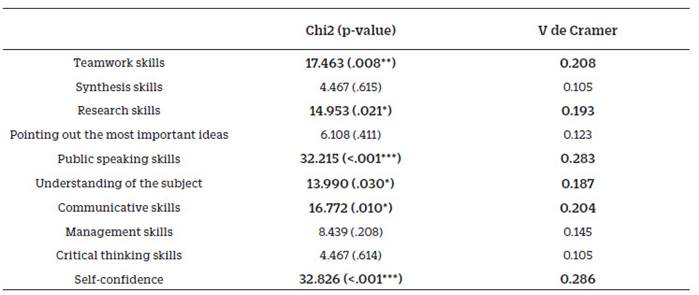
Note. * p <0.05; ** p <0.01; *** p <0.001
Some significant differences can be found in some of the issues raised (p<0.05). However, the indices for the effect size indicate that the differences found are not of very high magnitude (V<0.3), so the relationships are not very intense and the dependence between factors is weak. For the interpretation, see Table 2.
Aerospace students are the ones who expect the greatest degree of improvement from the project. Based on the post-hoc contrasts by pairs with Bonferroni adjustment, those in electrical and mechanics expect to improve mainly their ability to speak in public and gain self-confidence. Those from product DD and industrial design see less potential: the former in public speaking and self-confidence, the latter in teamwork, researching and pointing out important ideas. On the other hand, management, critical thinking, and self-confidence are skills students do not believe that they will be able to develop too greatly, since they are the three least scored. Product DD engineering and industrial design engineering are the specialities with the lowest expectations in this regard. It is striking, as well, that the lowest scores fall on understanding of the subject, management, and critical thinking skill by electrical engineering.
The rest of the items in the questionnaire (Q12, Q13, Q14, Q17, Q18, Q19, Q20, Q21, Q22, Q23, Q24 and Q25) correspond to other dimensions on which the project can have a positive impact. They were answered in terms of degree of agreement with a specific statement on a scale of 1-totally disagree to 7- totally agree. Figure 2 represents mean values of the recorded scores:
Kendall’s concordance coefficient (W) yields a value of 0.394 with a p-value of 0.000, so there is significant agreement between the scores of the interviewees for the 12 items with a weak magnitude of said agreement (W oscillates between 0 and 1).
The general degree of agreement can be labelled as moderate (1-2-3 low; 4-5 moderate; 6-7 high). The averages range between 4.5 and 5.5, falling thus within the "agree" category. Yet, it is worth noting that in certain items related to teamwork (greater learning, more pleasantness, and more personal relationships with colleagues), opinions are around 5.5 (between "agree" and "strongly agree"). These results concur with previous studies that have highlighted the skills of teamwork as a way to enhance productivity in the workplace (Bailey et al., 2001) and the capacity to work as part of a multidisciplinary team (Herrera et al., 2017). It is also noticeable that the participants agree on the fact that working on a project and presenting it by means of a poster will be fun, a good way to demonstrate their knowledge of the subject in question as well as their general knowledge.
Among the ratios of Cohen’s d values, it is worth mentioning, for example, that for Q12 aerospace engineers have more fun than electronic engineers (effect size d:1.47 high) or for Q17, mechanical engineers get more nervous than aerospace engineers (d:0.84, size high).
As can be seen in Table 3, there are many differences depending on the engineering degree being studied. For instance, regarding "satisfaction", aerospace engineers are the most satisfied. So are the DD product students, although there are specific cases with little agreement. On the contrary, those of industrial design seem more dissatisfied. We concede this is perhaps due to the students’ profile corresponding to each speciality, or their future professional opportunities. However, it seems that the differences are minor in some respects related to "teamwork".
Table 3 Degree of agreement with expectations according to degree (Kruskal-Wallis test results)

Note.* p <0.05; ** p <0.01; *** p <0.001
Bearing the above results in mind, it could be stated that teamwork is the skill that engineering students would most expect to develop through the development of an academic poster in a small group.
Post-questionnaire
Two thirds of the participants express their total satisfaction with the task carried out, as shown in Figure 3.
There are no significant differences in the level of satisfaction according to the degree of origin (p = 0.672, Chi2 test).
Regarding question 18 (In general, creating an academic poster will help me improve my…), their prior perceptions have been confirmed after the educational experience. The skills that they claim have been improved by creating an academic poster tally with those identified in the pre-questionnaire: teamwork, research skills and synthesising information (see Figure 4).
A battery of statistical tests was carried out to evaluate possible differences according to engineering degree: (Table 4)
Some statistically significant differences can be found in some of the issues raised (p<0.05). However, the effect size indices indicate that the differences found are not of very high magnitude (V<0.3) except for public speaking in which the effect size is medium. It is the product design and development engineers who have least developed the ability to speak in public whilst aerospace engineers have developed it the most.
For the interpretation, see Table 5.
Aerospace students are those who recognise the greatest degree of improvement after presenting the project. Based on the post-hoc tests by pairs with Bonferroni adjustment, those from electrical engineering have strengthened their communication skills, but they are also those who have learned the least from teamwork, research skills or understanding of the subject. The DD product degree presents quite low percentages in aspects related to public speaking.
In items 15 and 16, students were asked which type of visual aid they preferred, either traditional presentations (PowerPoint, etc.) or the academic poster. It is noteworthy that the sample (Figure 5) is almost symmetrically distributed between the two options.
Participants were further questioned about the reasons for their choice. The following figure shows the results that present the greatest differences between traditional presentations and presentations with the aid of an academic poster.
The Chi2 value of 177.769 (p<0.0001) and the high value of Cramer’s V of 0.787 (p-value 0.000) indicate a strong relationship between the reasons for choosing one type of presentation or another. Post-hoc tests with Bonferroni adjustment for pairwise comparison indicate that the oral presentation with a poster is chosen above all because it is more visual, enjoyable and synthetic than the traditional presentation.
Those represented are the most named attributes as a whole and for which the differences are also significant. The participants uphold the view that traditional presentations are more visual and easier to explain, as they include both visual material and slides. They also allow participants in the presentation to follow the script determined by the slideshow. Although, as García-Manso (2019) argues, posters also combine visual material and text, the participants concede that a PowerPoint presentation facilitates, according to them, anxiety control by the speaker, as they feel more self-confident. Students underscore that they prefer it, precisely, because they are not good at oral presentations. They seem to be further acquainted with PowerPoint presentations because it is the resource that they use most in their presentations. Additionally, the possibility of including much more information, as well as various resources (videos, audios, photographs, etc.) that facilitate explanation and learning are highly valued.
On the other hand, poster presentations seem to be much more entertaining, attractive, and motivating for both the speaker and the audience. It implies a greater degree of interaction with the listener and enhances communication skills, better capturing thus the listener’s attention. It is a more dynamic type of presentation, which is preferred for its novelty. It is different and innovative. Those who prefer it stress that it is ideal because it can summarise the key ideas and give a more global vision of the subject in question. According to the respondents, it facilitates learning by being more personal and concentrating on the important points.
Comparison of pre-questionnaire and post-questionnaire
As already mentioned, the comparison between the two waves is consistent if both are homogeneous in profile variables. As shown in Table 6, our sample presents a high degree of homogeneity and there is no relevant bias.
Table 6 Homogeneity of the pre- and post-wave samples

Nota. Chi2 test and Mann-Whitney test results. * p <0.05; ** p <0.01; *** p <0.001
There are five skills whose scores differ between pre and post (p-values <0.05). The discrepancies between the incidences of each wave are insignificant (V<0.10) for Research skills, while for Teamwork skills, Synthesis skills, pointing out ideas and public speaking skills the discrepancies between waves are low (V between 0.10-0.29).
Expectations regarding general issues such as teamwork, the synthesis of information, ability to research, public speaking and the highlighting of key ideas were very high, but after the completion of the project the same issues received lower ratings (Table 7). However, for the rest of the issues such as understanding, communication, management, self-confidence, and critical thinking, the expectations have been fulfilled. Regarding enjoyment, demonstration of knowledge, teamwork, stress control, etc., the degree of agreement with the expectations formulated, in terms of statements, was moderate.
Cross-curricular competence questionnaire
The number of respondents varies (between 92 and 101) depending on the question, which for a total of 267 enrolled students represents a maximum sampling error in the range 7.7-8.3%. All medians have a value of 3, that is, a medium-high degree of acquisition. In terms of means, homogeneity is also absolute, with values ranging from 2.9 to 3.2. The following graph summarizes the results and allows a comparison of all the competences evaluated.
The results are, once again, consistent with those obtained through the previous questionnaires. Within a high level of appraisals, teamwork stands out. On the contrary, comprehension and integration are the lowest scored, together with effective oral and written communication, but within a great general level and with slight differences between skills. However, these data make us think about the possible causes. A significant group of students (102) were unable to give their oral presentations in person due to the COVID-19 pandemic restrictions, which required their presentations to be done through virtual means. Without a doubt, this circumstance has constituted a major shortcoming in the investigation. We concede that this fact may have influenced their responses and consequently the results may have been misrepresented. This could be the case of some cross-curricular competences such as effective oral and written communication, which might have been underrated.
Engineering students are required to develop a series of cross-curricular competences upon completion of their university studies, a fact which has even been supported by ABET (Shumann, et al., 2005). The Universitat Politècnica de València, conscious of the importance of these competences, supports their teaching and learning and implements innovation projects in order to improve the quality of education. Within this context, the work at hand explored the academic poster potential as a pedagogical resource for the promotion of cross-curricular competences in engineering undergraduate students.
Based on our findings, we can conclude that the participants’ expectations about the CTPOSTIC project were very high on general issues such as teamwork, synthesising information, ability to research, public speaking and the highlighting of key ideas in a research project or a presentation, although final assimilation rates are significantly lower. As for the rest of the issues, their expectations were fulfilled. Regarding more specific issues, the degree of agreement with the expectations formulated, in terms of statements, was moderate and this has been confirmed after the completion of the project. As regards comparable aspects, no changes have been detected.
On the other hand, students equally prefer traditional and poster-based presentation formats. The strengths of the poster are, according to the respondents, enjoyment, potential to interact with the audience, dynamism, ability to synthesise information, and keeping attention, which would favour the assimilation of key concepts and ideas. On the contrary, the participants report that more stress control and oral skills are required when presenting a poster, since it is not possible to rely on a script or to extend the information as much as can be done through other types of visual formats such as PowerPoint or other similar resources.
From the analysis of the self-assessment questionnaire of cross-curricular competences, it is concluded that the degree of acquisition has been high, without great differences among engineering specialties. Yet, the result obtained in relation to communicative competence has been lower than we expected. For this reason, the next step to advance in the project will be to carry out improvement actions during the next academic year. A limitation of this study is that, since the participants were university students from Valencia (Spain), the results cannot be generalised to other geographical regions or universities.
Several shortcomings need to be acknowledged. First of all, no quality control protocols have been used to manage the dataset. Likewise, our data are based on the students’ own perspective on the use of the academic poster by means of a questionnaire. However, the questionnaire or self-report is one of the best possible approaches for the type of study that we present here.
Secondly, in order to reduce the effect of the social desirability interference, anonymity was guaranteed to the participants by means of the informed consent. In addition, the use of a computer to complete the questionnaires makes the process more impersonal and increases the degree of neutrality so that the interference of social desirability can be reduced. However, other data collection instruments would be required to triangulate the results and eliminate possible interference with students’ pre-conceived ideas or other similar experiences that could slightly affect the findings.
Finally, no control group has been used so that the results gathered could be compared against the backdrop of more traditional methodologies.
All in all, the results of this study support future decision-making regarding the implementation of the academic poster as an alternative to traditional formats for presentations in engineering education. Drawn from the results, we can state that the use of academic posters can be an asset to enhance academic performance, as well as facilitate the promotion of cross-curricular competences.














